Mining is the lifeline of the crypto world. It validates ongoing transactions and mints new coins into circulation. In straightforward terms, a miner solves some complex math problems to verify the transactions.
It is the process by which miners trade their computing power and electricity for the block reward, which is the incentive to help sustain the blockchain technology behind cryptocurrencies.
It’s great if you have a cryptocurrency wallet upfront. However, you can first opt for the mining platform and go with its recommended wallet later.
I will directly discuss the platforms based on their payout terms, security, and more. You can also check out the benefits of mining cryptocurrency, who can mine it, and the differences between mined and non-mined cryptocurrencies at the end of the list.
Disclaimer: Crypto mining involves significant risks, including but not limited to high energy consumption, hardware degradation, crypto volatility, regulatory uncertainty, cyber threats, and potential tax implications. Proceed at your own risk!
- 1. Braiins Pool
- 2. Cruxpool
- 3. 2Miners
- 4. Hiveon
- 5. ECOS
- 6. Kryptex
- 7. BitFuFu
- 8. Awesome Miner
- 9. Salad
- 10. NiceHash
- Show less
You can trust Geekflare
At Geekflare, trust and transparency are paramount. Our team of experts, with over 185 years of combined experience in business and technology, tests and reviews software, ensuring our ratings and awards are unbiased and reliable. Learn how we test.
1. Braiins Pool
Braiins Pool, earlier known as Slush Pool, is an excellent place to step in for anyone aiming for pool mining.
It’s one of the veterans in bitcoin mining, presently mining about 1.08% of all bitcoins. Their website has guides about getting started with their platform, hardware suitability, payouts, and more.
Braiins Pool charges a 2.5% pool fee for using its platform. It also has a 0% pool fee option for some supported ASIC miners.
Its platform has two-factor authentication (2FA) for added security. In addition to the regular OTPs, you can use FIDO2-compatible physical authentication devices like the TREZOR or Yubikey. You can also share account access with partners/colleagues and export mining data via an API.

It also has an official mobile app for iOS and Android. The app can be used as an account monitoring tool to receive pre-configured notifications, such as hashrate changes.
Braiins Pool has Bitcoin mining servers across the continents, including the USA, Europe, Brazil, Canada, Russia, and Singapore.
Braiins Pool Payout Terms
Though the minimum payout is 0.0002 BTC, you pay a payout fee of 0.0001 BTC for transactions lower than 0.005 BTC. Maximum payout is capped at 5 BTC. There is no payout fee for the Lightning Network payouts.
2. Cruxpool
Cruxpool supports mining Bitcoin, Ethereum Classic, Ravencoin, Ergo, and Flux. Mining with Cruxpool is pretty straightforward, where you can start with a suitable wallet address. Another, and less anonymous, method is to create an account with Cruxpool before mining.
The platform has guidelines for every eligible coin, which include pool fee, get-started tutorial, hardware requirements, reward system, profit estimates, and more.
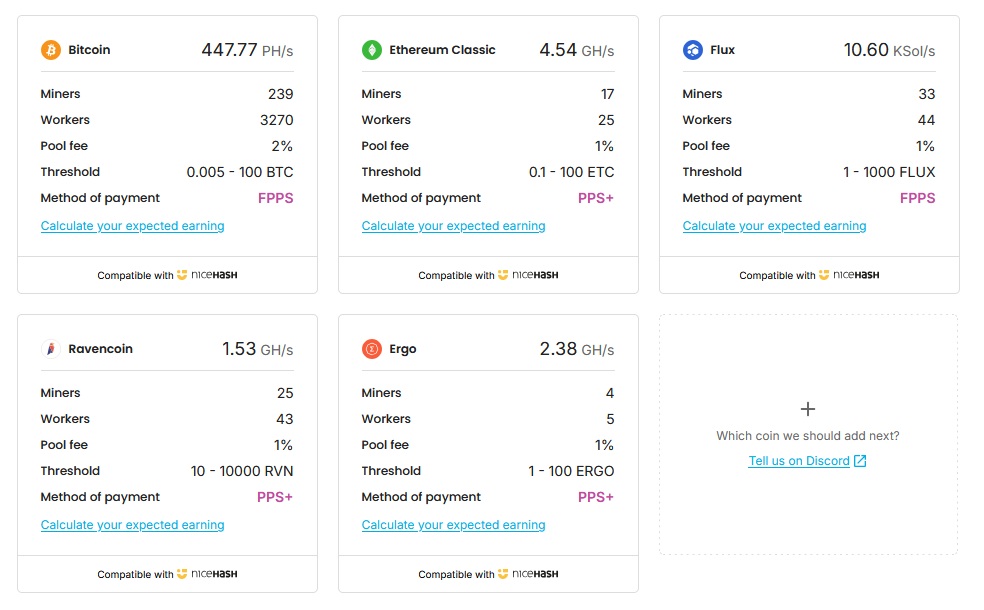
Cruxpool also works if you’ve rented hashrate at NiceHash.
Cruxpool Payout Terms
Bitcoin payments are dispatched daily, while others are issued every three hours, provided the user has a minimum account balance as indicated below.
- Bitcoin – 0.005 BTC
- Ethereum Classic – 0.1 ETC
- Ravencoin – 10 RVN
- Ergo – 1 ERG
- Flux – 1 FLUX
3. 2Miners
2Miners lets you solo and pool mine 20+ cryptocurrencies, including Ethereum Classic, Ravencoin, Ethereum PoW, Zcash, and Bitcoin Cash.
The home page mentions all the coins you can mine with 2Miners. Additionally, it provides information about the hashrate, payout cryptocurrency, and minimum payouts.

Every coin mining page lists the activity timeline, such as the latest blocks, luck, and reward. You can also check the reward transactions and cross-verify on the respective blockchain explorer. Lastly, beginners have tutorials covering suitable hardware, profit estimates, and software configurations.
2Miners Payout Terms
2Miners issues payments every two hours, provided the user account has reached the minimum balance, which is listed on the specific coin mining page. Fees range from 1-1.5% based on the type of mining: pool or solo.
4. Hiveon
Hiveon lets you pool mine Bitcoin, Ravencoin, and Ethereum Classic. There are two ways to mine with Hiveon: Hiveon OS and Windows apps.
Hiveon OS is recommended for mining farms that manage thousands of rigs. It supports a variety of ASIC models, including Antminer, Innosilicon, Zig, and more. This helps you monitor hashrates, errors, team activity, pool configurations, and power consumption. Besides, you can remotely troubleshoot GPUs, push updates, switch pools, manage wallets, etc., from a single place.
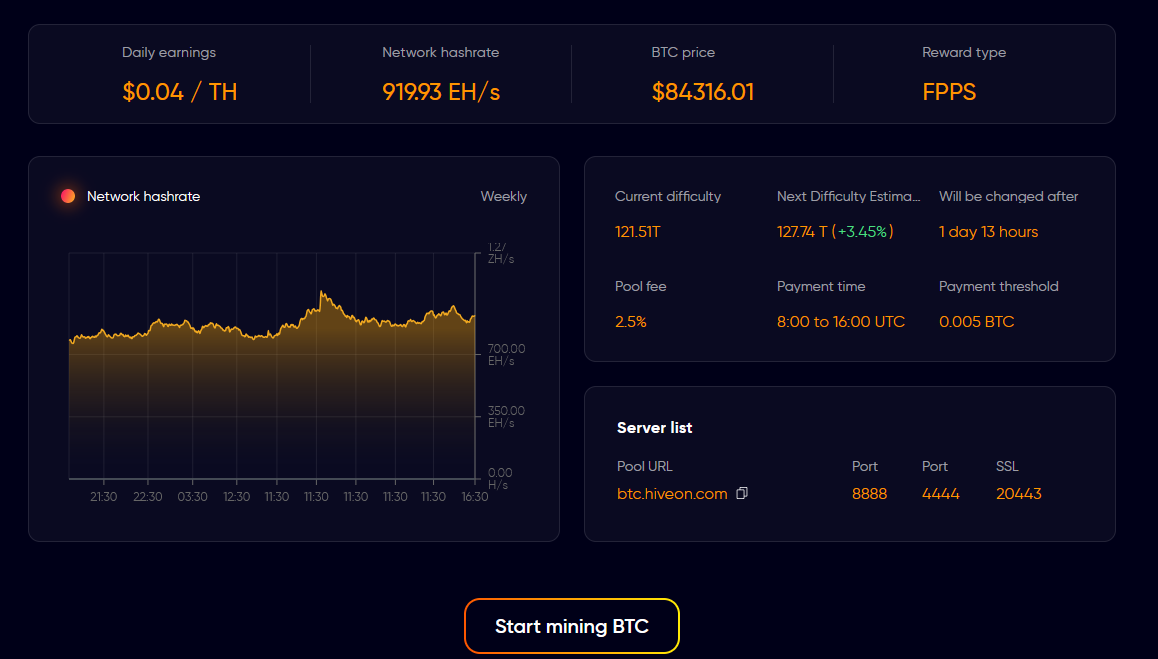
Then there are Windows mining software for specific GPU manufacturers (AMD and Nvidia) and GPU combinations (AMD+NVIDIA).
The best part about Hiveon is that it has a 0% transaction fee for all three coins that it supports as of now.
Hiveon Payout Terms
Hiveon pays daily if the net balance exceeds minimum thresholds, which are 0.005 BTC, 1 ETC, and 10 RVN.
5. ECOS
Founded in 2017, ECOS is an Armenia-based crypto group with various products, including mining farms, ASICs for purchase and rentals, cloud mining, miner hosting, and a crypto wallet.
At ECOS, you can mine Bitcoin in 2 ways: by cloud (or rentals) mining or by buying an ASIC. For cloud mining or rentals (essentially the same), you can simply select the preferred device, check the particulars, and proceed with the purchase.
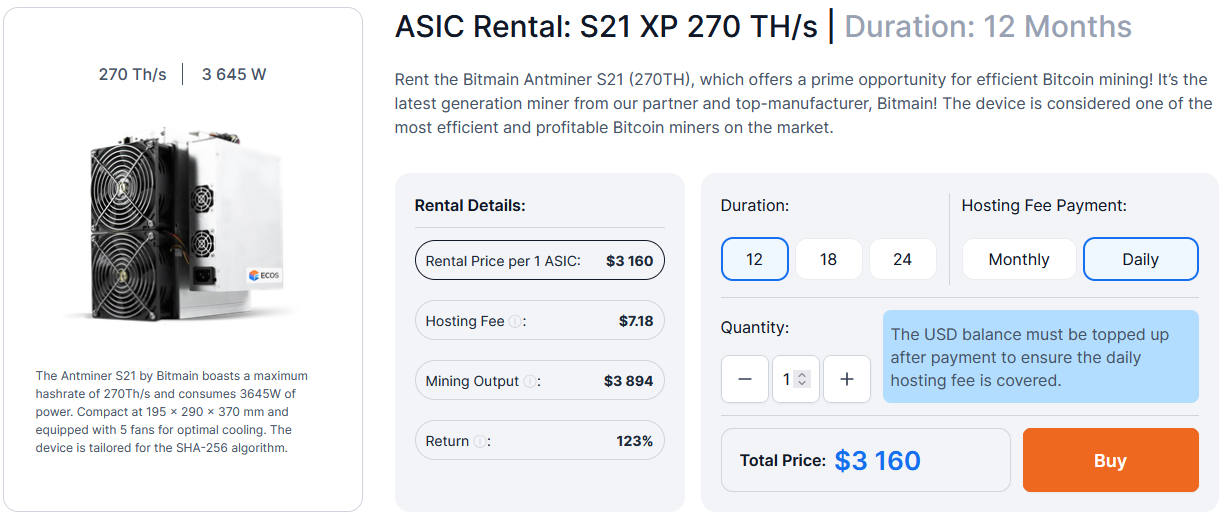
The second way to mine BTC is to buy an Antminer, which ECOS hosts at its own mining facility in the Free Economic Zone in Armenia. ECOS takes care of all the technical hassle, including:
- Logistics
- Customs clearance
- Installation
- Set-up
- Routine maintenance
However, that also means you won’t have direct control over the mining equipment. Therefore, try the rentals first before committing to a major purchase.
You can get started with ECOS on their website. Besides, they also have mobile apps for iOS and Android. This helps you stay on top of your crypto investments wherever you go.
ECOS Payout Terms
Users get their BTC mining rewards credited to their ECOS wallet daily. Minimum withdrawals are 0.001 BTC, 0.014 ETH, 40 USDT, 30 XRP, and 0.042 BCH.
6. Kryptex
Kryptex aims to bring mining to the masses with its effortless setup. Just download the application, and check the expected earnings with your ASIC, FPGA, or GPU setup.
Next, create an account and let it run in the background while you work. Kryptex also has a mining calculator that checks revenue based on hardware potency.
Krptex has two mining modes, Lite and Pro. Lite does not affect your computer much, while Pro takes up maximum computing resources for greater revenue. In addition, you can choose to use the CPU or specific GPUs to deploy for mining, giving you a greater degree of control.
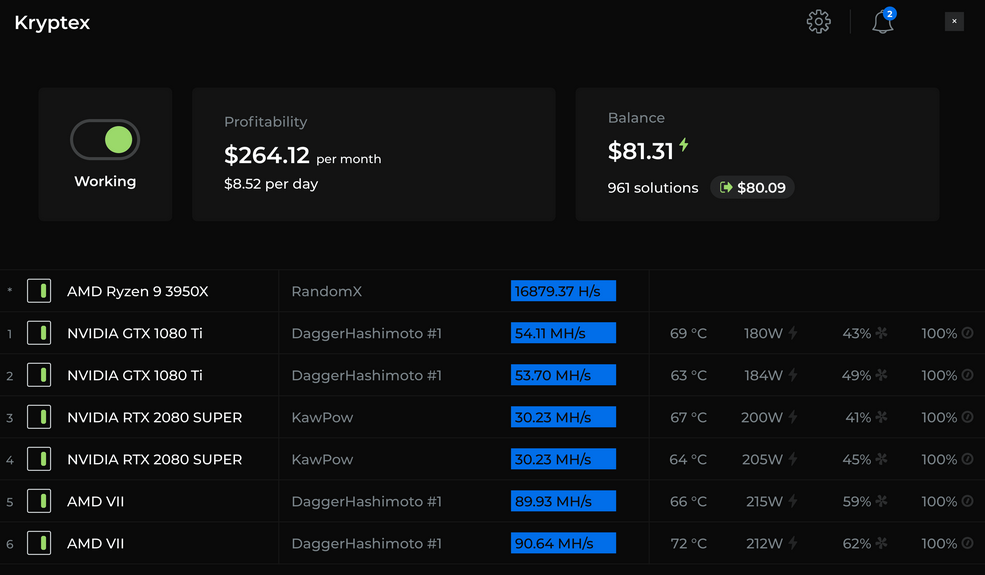
This mining platform features a profitability calculator where you can choose the hardware and the electricity price for a daily profit estimate. Afterwards, you can download the application and start mining your preferred mining from a long list of altcoins, such as ETHW, ETC, RVN, and ERG.
You can also choose to pool mine with Kryptex’s own pool, promising stable returns in BTC.
Lastly, payouts are protected by two-factor authentication, and one can ask for support in their Telegram channel for any issues. Kryptex also has mobile apps for iOS and Android.
Kryptex Payout Terms
Minimum payouts are 0.00025 BTC, 0.03 ETH, 0.015 LTC, 10 USDT, etc. You can check the full list on their Kryptex fees section.
7. BitFuFu
BitFuFu offers both cloud mining, rentals, and miner co-hosting. Currently, BitFuFu is the sole strategic partner of BITMAIN, the largest crypto mining ASIC manufacturing company.
They have two cloud mining modes, easy (up to 50 days) and pro (up to 360 days). Easy is a low-barrier entry for beginners, offering one-click orders with all-inclusive fees and daily rewards. Pro is for power users, where they can start mining while paying a part of the service fee and pay the remaining while BTC soars high for overall high net gains.
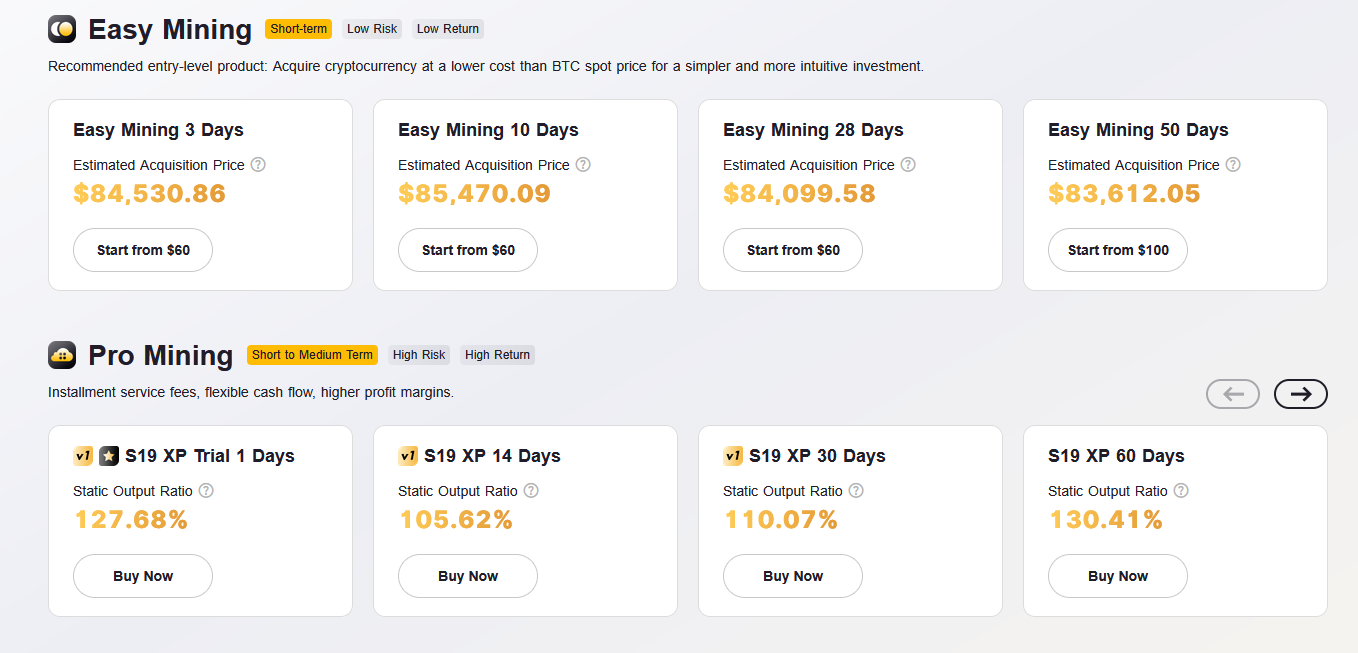
You can also mine with rentals. As of this writing, BitFuFu has two plans based on the duration, 360 and 540 days, both using the same ASIC, Bitmain’s S19 XP 140T.
Miner Co-Hosting is purchasing ASIC units and leaving it up to BitFuFu to carry out mining (and share profits) and have the device ownership afterwards. Co-hosting is only available through BitFuFU’s mobile apps for iOS and Android.
Lastly, BitFuFU lets you join one of the two biggest mining pools, Antpool and F2Pool.
BitFuFu Payout Terms
Minimum daily payout is 0.005 BTC, with the absolute minimum threshold for personal wallet transfers of the remaining amount being 0.000054 BTC.
8. Awesome Miner
Awesome Miner is a mining management utility for Windows and Linux users. It can handle up to 200K ASICs and 25K GPU/CPU miners and support one-click setups for over 10 pools, including 2Miners, IceMining, NiceHash, and Slush Pool.
You wouldn’t have any issue with ASIC support either, as it works with hundreds of ASIC miner models, including Bitmain Antminer, Canaan Avalon, Innosilicon, Goldshell, and MicroBT Whatsminer.
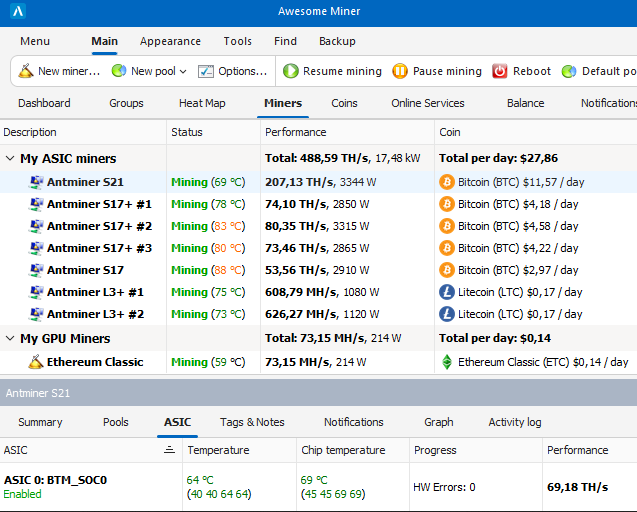
It has a cloud subscription that offers mining management from anywhere with just an internet connection. You can start with 2 miners without any subscription and limited features. Afterwards, this service starts at USD 4 per month for two miners, but all features are included.
Awesome Miner has a web interface you can access from any desktop or mobile device. It also supports delegating work with access-controlled user accounts, including allocating a specific miner for a user.
Awesome Miner seems to be an excellent solution for huge mining farms. It has rich documentation and helpful sections to assist users in every possible way.
9. Salad
Salad is a globally distributed cloud compute network that rewards its participants. It’s another user-friendly way into the crypto-mining universe. This comes as an application you can install to earn rewards in the background in exchange for device computing and bandwidth.
It features an ‘Auto Start‘ mode, which detects keyboard inactivity to maximize mining performance and profits. In addition, the application gives the option to activate/deactivate the CPU and GPU(s) while indicating the % utilization.

In addition to mining crypto, Salad can help you deploy computing for AI/ML inference and/or share bandwidth for its streaming services.
Salad Paytout Terms
The payouts can be redeemed in the store for digital purchases, including Discord Nitro subscription, Amazon gift cards, PayPal rewards, Stream Gift Cards, etc. You can also donate earnings directly to the listed charities. Overall, it’s an effortless method to earn from idle resources, only if you can keep tabs on your local electricity rates.
10. NiceHash
NiceHash has an excellent portfolio of crypto-related services. It has a hashrate marketplace, crypto mining utility, crypto payments service, and crypto exchange.
There are multiple ways to mine with NiceHash.
First is EasyMining, where you can mine crypto by buying hashrate for highly contested networks such as Bitcoin. It’s compatible with 2Miners, Braiins Pool, Cruxpool, DxPool, and more.
Another method is to download the appropriate NiceHash application and mine with local resources. There are separate applications for managing mining operations with CPUs, GPUs, and ASIC units.
NiceHash supports over 30 algorithms and has features such as profit switching, making it an excellent pick for beginners to expert crypto farmers.
Depending on the hardware— CPU/GPU or ASIC— you can find detailed tutorials on how to start mining with them.
Finally, you have NiceHash OS (NHOS for Windows, macOS, and Linux), which you can use to connect to unlimited mining rigs for free. It’s perfect for managing large mining setups and comes with features such as remote monitoring, remote overclocking, auto updates, and algorithm switching.
NiceHash Payout Terms
The minimum payment threshold at NiceHash is 0.00001 BTC. Users are paid every four hours with a service charge of 2%. NiceHash enables its users to customize minimum payouts, split rewards, and automate withdrawals.
Honorable Mentions
11. Minerstat: Supports personal mining and farms to mine 250+ coins across 4000+ pools.
12. Zionodes: Buy (sell/host/tokenize) optimized rigs with pre-installed mining software
13. Bitdeer: Bitcoin cloud mining
14. Compass Mining: Bitcoin mining hardware and hosting
15. Binance: Mining pools for 10+ coins, including BTC, BCH, LTC, ETC, and ETHW
Benefits of Crypto Mining
Crypto mining can be a pretty good side or primary gig based on your resources and how far you want to go. With little analysis, you can generate passive income based on what equipment you have at hand.
Mining also lets you take pride in being a vital component of the crypto universe, as miners are the primary contributors to making decentralized finance a reality.
Finally, you have veto power over any changes in the network protocols.
All that said, the major driver is mining rewards. And for that, you need to be careful to only mine coins where you can be profitable. Though most platforms I have discussed above have their own profitability calculators, you can also check WhatToMine.
Mined vs. Non-Mined Cryptocurrency
A consensus mechanism is a method to approve transactions in a decentralized system such as a blockchain. It also assists in keeping the system secure from possible vulnerabilities such as a 51% attack.
A 51% attack is when a bad actor controls more than 51% of the assets of a blockchain. This majority powers the fraudster(s) to twist the protocols as they see fit. A consensus mechanism keeps the power decentralized. Higher degrees of decentralization require enormous computing capabilities and work to perform a 51% attack. This makes the network resistant to such crypto cyberattacks.
There are plenty of consensus methods like proof-of-work, proof-of-stake, proof-of-capacity, and proof-of-activity. Depending on the type of consensus mechanism, crypto coins may require mining or otherwise.
Mined Cryptocurrency
Blockchains using a proof-of-work consensus mechanism need mining.
They use miners to approve the entries (transactions). Whenever transactions go up for verification, miners compete to solve for a 64-digit hexadecimal number.
The first one to find the solution broadcasts it to the entire network as proof of work. This victory bestows the reward on the winner while others wait for the next challenge.
This process repeats every time for a block worth of transactions.
Bitcoin uses proof-of-work and many others. Therefore, they need mining to check double-spending.
The only drawback with the proof-of-work is the energy consumed and time taken per transaction, as all the miners except the winner end up wasting their computing power for nothing.
Non-Mined Cryptocurrency
All cryptos that don’t use proof-of-work are non-mineable, such as Ethereum, Ripple, Cardano, etc.
They use more energy-conservative methods to validate the transactions. Proof-of-stake is one such consensus protocol that is an alternative to proof-of-work.
Proof-of-stake removes the competition. Blocks are not mined. Instead, they are validated by the stakeholders. Validators are chosen at random. They stake their share of crypto to approve any block. And they lose their stake (partial or full) based on the degree of misconduct.
Also Read: Best Crypto Staking Platforms
While proof-of-stake is eco-friendly, it has its own set of drawbacks, such as its promotion of amassing crypto rather than its expenditure.
Who Can Mine Cryptocurrency?
In general, anyone with a supported wallet, internet connection, and powerful hardware can start mining cryptocurrency. It also depends on the type of cryptocurrency you choose to mine.
You can either go with solo mining or pool mining.
In solo, you alone solve for the hash, while it’s more of a group effort in the pool. Similarly, it’s also based on the type of hardware you’ve deployed, CPU, GPU, or professional ASIC units.
So, the short answer is — yes. You can mine cryptocurrency with the right equipment.
Conclusion
While it seems logical to put idle computing power to mining, some degree of technical proficiency is essential to churn profits and avoid losses. When choosing any crypto mining platform, the critical factors remain supported coins, mining algorithms, reward systems, minimum payout, withdrawal fee, and user reviews.
Despite its popularity, crypto mining isn’t for everyone, especially those with ineffective hardware or with high electricity rates; they should analyze profitability first.
Explore more on Crypto Mining
-
 EditorRashmi Sharma is an editor at Geekflare. She is passionate about researching business resources and has an interest in data analysis.
EditorRashmi Sharma is an editor at Geekflare. She is passionate about researching business resources and has an interest in data analysis.


